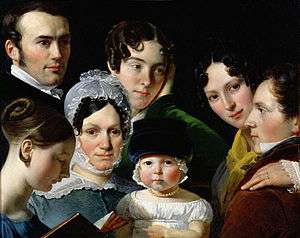Claude-Marie Dubufe
Claude-Marie-Paul Dubufe (1790 – 1864) a French historical, genre and portrait painter, was born in Paris in 1790, and studied under David. His subjects were at first classical, and then scriptural. He then gave himself up to the painting of genre pictures and portraits.[1] His reputation rests chiefly on his portraits, of which he produced a large number. Dubufe, who was the last representative of the school of David, died at Selle-Saint-Cloud in 1864. Amongst his chief works are:
- A Roman suffering starvation with his family rather than touch a sum of money entrusted to him. 1810.
- Christ allaying the tempest. 1819.
- Apollo and Cyparissus. 1822.(Musée Calvet - Avignon)
- The Birth of the Duke of Bordeaux. 1824. (Orleans Museum.)
- The Passage of the Bidassoa. 1824.
- Four frescoes representing 'Egypt,' &c. (Conseil d'État, Paris.)
- The Surprise. 1828. (National Gallery, London.)
- Portrait of Louis Philippe.
- Portrait of General Montesquiou-Fezenzac (Versailles).
- Portrait of Nicholas Koechlin. 1841.
- Portrait of the Queen of the Belgians.
- Portrait of Virginie de Ternant (Marquise de Dansville-Sur-Meuse) (False River, Louisiana).
- Portrait of Marius Claude Vincent de Ternant (False River, Louisiana).
- Portrait of Marie Virginie Avegno (nee' de Ternant) (False River, Louisiana).
- Portrait of Julie Euriphile de Ternant (False River, Louisiana).

 Anne-Louise Alix de Montmorency, with her daughter, ca. 1840
Anne-Louise Alix de Montmorency, with her daughter, ca. 1840 Eleonor Jenkinson
Eleonor Jenkinson
Notes
- . New International Encyclopedia. 1905.
gollark: (streaming SIMD extensions e).
gollark: DO NOT give arbitrary people your name, ssee.
gollark: That is the correct response, yes.
gollark: Anyway, maybe you should go closer to the cognitohazard and see if it's cognitohazardous.
gollark: Added to your psychological profile.
References

This article is issued from Wikipedia. The text is licensed under Creative Commons - Attribution - Sharealike. Additional terms may apply for the media files.
